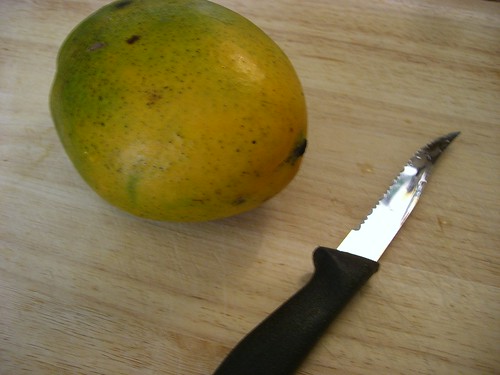1. Start with a good, ripe mango. That is, it should yield to pressure just a hair over "slightly."

2. Slice off the mango's "cheeks." Think of your mango in terms of having three parts: two sides and one seed. The cheeks are the meaty sides of a fruit. You can tell by the shape of the body which direction the seed lies inside.
Use a sharp knife and cut as close to the seed as you can on either side. You will then have three parts.

3. Score the flesh into cubes, but only cut to just inside the skin; then invert to make the cubes pop out for easy removal.

The real key here is to make sure your mango is ripe. You may need to experiment over time to get a good sense of when a mango is at its peak. If it doesn't yield to gentle pressure, it's not ready.
How do YOU slice your mangoes? Comment and share!
Coming up: A short infomercial, and Make a Fruit Smoothie in less than a minute!






That's pretty much the way I do it. Except that I don't slice the sides off leaving a piece in the middle. I score all the way around, cutting all the way to the pit, then use a soup spoon to go down in from the top and separate the two sides from the pit. Then I score it into cubes and turn it inside out like you do.
ReplyDeleteI grew up eating mangoes by the bushel over in Africa!
You must have better knives than I do. ;o) That definitely sounds much more efficient! Slicing off the sides first does leave the mess task of having to nibble off the fruit from the seed...
ReplyDeleteI BET you had lots of mangos in Africa! How did they compare to the ones in the States? Or was there no comparison?